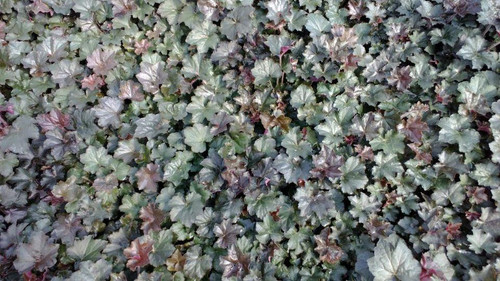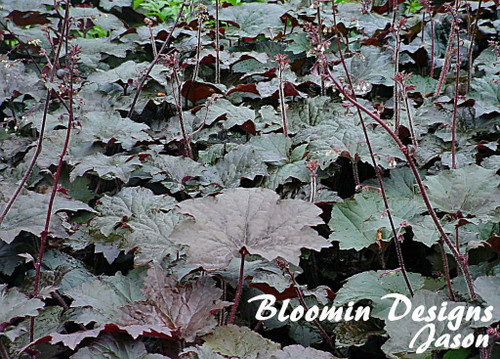Product Description
Heuchera micrantha 'Palace Purple' (30)ct Flat
Common name: Coral Bells
The original purple coral bells, 'Palace Purple' is perhaps the most well-recognized and widely planted variety of all heucheras. It was the 1991 Perennial Plant Association Plant of the Year.
This selection has very large, shiny, and star-shaped leaves, ranging in color from deep olive green to purplish-bronze. Their undersides, which are quite visible in the loosely formed clumps, are a striking metallic amethyst purple. The 20-inch tall, leafed flower scapes bear an abundance of tiny cream flowers.
Coral bells are easy to grow and blend easily with most other perennials in the landscape. Because of their low, mounding habit, they are often used as edging along paths or in containers. Try cutting a few of the tall flower scapes for fresh bouquets.
Heucheras are easy perennials to grow and fit nicely in the front of any border, rock garden, or container. They grow most vigorously and have the stongest colors when grown in partial shade (preferably afternoon shade). They can also be grown in full shade, but their growth rate will be very slow. Some varieties can withstand full sun in northern climates if they have consistant moisture, but their colors tend to fade with the intensity of the sun. The soil should be amended with organic matter prior to planting. It should also have good drainage and a neutral pH.
Heucheras are evergreen in areas with mild winters. If properly sited out of the way of winter winds and with reliable snow cover, gardeners in northern regions may also find their heucheras acting as evergreens. If the plant looks tattered by early spring, shear off any damaged leaves to make room for the vibrant new foliage which will fill in quickly.
Heucheras can be grown under Black Walnut trees because they are resistant to the toxin Juglone which the trees emit from their roots.
Heucheras are also salt tolerant. They are useful in the north along pathways which are salted in winter or for people gardening in coastal regions. Occasionally in northern regions, heucheras have a tendancy to heave out of the ground because of the freeze/thaw cycle. To combat heaving, add an extra layer of compost around the plant's roots in the fall. In the spring, if the plants have heaved at all, the new roots will grow into the fresh new layer of compost.
Perennial Plant Association Plant of the Year -- 1991
Height: 8.0-12.0 Inches
Spread: 12.0-16.0 Inches
Scape Height: 26.0 Inches
Hardiness Zones: 4,5,6,7,8,9
Flower Color: White Shades
Foliage Color: Multicolored
Full Sun (> 6 hrs. Direct Sun) to Full Shade (< 4 hrs. Direct Sun)
Average Water Needs
Average to Fertile Soil Quality
Bloomtime: Late Spring - Midsummer
Attracts Butterflies and Hummingbirds
Bee Friendly
Evergreen
Growth Rate: Medium
Border Plant, Container, Cut Foliage, Easy To Grow, Edging, Mass Planting, Salt Tolerant
Heuchera micrantha 'Palace Purple', commonly known as alum root or coral bells, is a popular perennial plant prized for its vibrant foliage and delicate flowers. It was a pioneering variety in the world of coral bells, hybridized naturally purple-leaved native species. Awarded the prestigious Perennial Plant of the Year in 1991, 'Palace Purple' helped spark the widespread popularity of coral bells in gardens. This captivating plant is a versatile addition to gardens, offering year-round interest with its colorful leaves and charming blooms.
Characteristics Heuchera 'Palace Purple' is valued for both its stunning foliage and its delicate flowers. The leaves are large, lustrous, and star-shaped, with colors ranging from deep olive green to purplish-bronze to brilliant deep purple. The undersides of the leaves display a striking metallic amethyst purple, adding another dimension to the plant's visual appeal. In late spring to midsummer, the plant produces panicles of small, bell-shaped, creamy-white flowers on slender, dark red stems that rise above the foliage. These delicate blooms provide a lovely contrast to the darker leaves. Heuchera 'Palace Purple' can also be used as a cut flower, adding to its versatility in the garden.
This clump-forming perennial forms basal mounds, typically reaching 8-12 inches tall with a spread of 16 inches. It is a sturdy performer that is easy to grow, requires little maintenance, and is generally pest and disease-free.
Bloom Time Heuchera 'Palace Purple' blooms in the summer. More specifically, the tiny, pinkish-white, bell-shaped flowers bloom in open, airy panicles borne on slender, wiry, dark red stems from late spring to early summer. These stems typically reach a height of 15-24 inches. The flowering period can extend from June through October.
Growing Conditions Heuchera 'Palace Purple' thrives in a variety of conditions, making it a suitable choice for many gardens. It performs best in part shade, in rich, humusy, medium moisture, well-drained soils. When grown in full sun, it is essential to ensure the soil remains consistently moist to prevent the foliage from declining. Once established, it can thrive in dry shade. The plant prefers organically rich soil and can tolerate both sun and partial shade. In hot summer areas, a part-shade location is recommended to prevent the leaf color from fading. When planting in full sun, extra care should be taken with watering, as the soil should not be allowed to dry out.
Heuchera 'Palace Purple' is hardy in USDA Plant Hardiness Zones 4a-9b. It can tolerate a range of soil types, including clay, loam, and sand, as long as they are well-drained. The soil pH should ideally be between 5.5 and 6.5. It is tolerant of juglone, a substance produced by black walnut trees that can be harmful to some plants. It is also salt tolerant, making it a good choice for gardens near pathways that are salted in winter or for coastal gardens.
To ensure the continued health and vigor of Heuchera 'Palace Purple', it is recommended to divide the clumps in spring every 3-4 years. Removing stems of faded flowers can promote additional bloom. In colder climates, where the ground freezes, applying winter mulch after the ground freezes can help prevent the plant from heaving out of the ground due to the freeze/thaw cycle. If heaving does occur, new roots will grow into the mulch layer in the spring.
Companion Plants Heuchera 'Palace Purple' pairs well with a variety of companion plants, offering diverse options for creating visually appealing combinations in the garden. Here are some suggestions:
- Hostas: The larger, lush foliage of hostas, such as 'Blue Angel' with its silver-blue leaves, creates a beautiful contrast with the more delicate Heuchera plants, particularly in a shade garden.
- Ferns: The delicate, feathery foliage of ferns, like the Jurassic™ Pterodactyl Eared Lady Fern with its pale green fronds and red stems, contrasts nicely with the more substantial leaves of Heuchera. Both thrive in similar woodland conditions.
- Astilbes: The plume-like flowers of Astilbes, such as 'Visions in Red' with its vibrant red plumes, and their fern-like foliage create a beautiful contrast with Heuchera, both in texture and color.
- Tiarella (Foamflower): Tiarella, such as 'Pink Skyrocket' with its pink flower spikes, and Heuchera are related and naturally complement each other well. They can even be interbred to form the hybrid x Heucherella.
- Grasses: Ornamental grasses, such as Hakonechloa macra 'Aureola' with its golden foliage, can add a different texture and form to the garden that complements Heuchera well, especially in sunnier locations.
- Bleeding Hearts (Dicentra): The arching sprays of heart-shaped flowers of Bleeding Hearts, such as Dicentra spectabilis 'Alba' with its pure white flowers, create a lovely contrast with the mounding habit and scalloped leaves of Heuchera.
- Pulmonaria (Lungwort): The silver-spotted leaves and early spring flowers of Pulmonaria, such as Pulmonaria 'Raspberry Splash' with its raspberry-pink flowers, work well with Heuchera, particularly in a shade garden.
- Japanese Painted Fern (Athyrium niponicum var. pictum): The silvery-grey foliage of this fern makes a stunning combination with purple- or lime-colored Heuchera.
Design Ideas and Uses Heuchera 'Palace Purple' offers versatility in garden design, thanks to its attractive foliage, compact size, and adaptability. Here are some ideas for incorporating it into your landscape:
- Edging and Borders: Its tidy growth habit makes it an excellent choice for edging paths or bordering flower beds, providing a neat and colorful outline.
- Containers: 'Palace Purple' thrives in containers, adding a touch of color and texture to patios, balconies, and other small spaces.
- Woodland Gardens: As a native woodland plant, it naturally fits into woodland gardens, where it can be planted under trees or in shady borders along with ferns, hostas, and other shade-loving plants.
- Rock Gardens: Its low-growing habit and tolerance for dry shade make it a suitable addition to rock gardens, where it can be combined with other drought-tolerant plants.
- Mass Plantings: Planting 'Palace Purple' in groups creates a dramatic effect, showcasing its vibrant foliage and adding a bold splash of color to the landscape.
Heuchera micrantha 'Palace Purple' is a remarkable perennial that offers both beauty and practicality for gardeners. Its vibrant foliage, ranging from deep purple to olive green, provides year-round interest, while its delicate, creamy-white flowers add a touch of charm in late spring to early summer. As one of the first hybridized coral bells with purple leaves, it played a significant role in popularizing this versatile plant. 'Palace Purple' is adaptable to a variety of growing conditions, thriving in both sun and shade, and tolerates juglone and salt. It is a low-maintenance plant that is easy to grow, making it suitable for gardeners of all levels of experience. Whether used as a border plant, in containers, or as part of a woodland or rock garden, 'Palace Purple' is sure to enhance the landscape with its unique charm and attract pollinators like butterflies and hummingbirds. Its versatility and resilience make it a valuable addition to any garden, adding color, texture, and a touch of elegance.
Thirty (30) plants per flat (or tray). Approximate Plug Measurements: 3 inches deep x 2 inches wide.
Other Details
The most important part of the plant is its root system. Healthy roots are the foundation of a healthy, vibrant plant. The type of plug container used is based on the specific needs of the plants. Perennials offered as bare root traditionally perform better when planted as bare root.Planted in a specialized mix, potted plants have well established root systems. Top growth stage will vary depending on the current life cycle and time of year when shipped. In Winter and early Spring dormant plants may be shipped. Dormant plants may be planted right away, even before the last frost date.
Most bare root varieties are field grown for at least one season, though Hemerocallis and Hosta are grown for two seasons. The bulk of the soil is removed during the harvesting process and the tops of most varieties are trimmed back to the crown. They are graded, packed in shredded aspen or sphagnum moss and stored in freezers until ready to be shipped.
See our Container Sizes and Bare Root Perennials pages for more information.
Plant information and care is provided in the Overview section, Plant Genus Page and general information is provided in the Planting Care & Guides. Additional questions can be asked on each Plant page.
Plant Spacing: Using the maximum mature spread or width of a plant to guide spacing, ensures space to grow to full size. To fill an area sooner, plant them closer together. Just remember, future thinning or transplanting may be needed.
Water: Keep a close eye on newly planted perennials, especially throughout the first growing year. Most early plant loss is due to too much or too little water!















